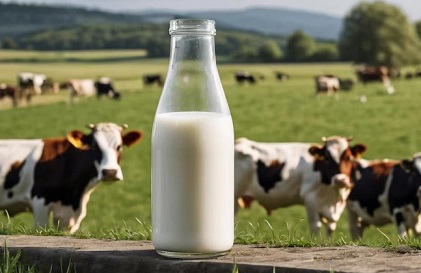New Study Challenges USDA and U.S. FDA Claims on Safety of Pasteurized Milk from H5N1 Infected Cows!
Nikhil Prasad Fact checked by:Thailand Medical News Team Jun 15, 2024 1 year, 4 months, 1 day, 16 hours, 14 minutes ago
H5N1 News: The safety of pasteurized milk from cows infected with the H5N1 bird flu virus has come under scrutiny following new findings by researchers at the U.S. National Institute of Allergy and Infectious Diseases (NIAID). Initial claims by the U.S. Department of Agriculture (USDA) and the U.S. Food and Drug Administration (FDA) that such milk is safe to drink are now being challenged, sparking a fresh debate on the potential risks to public health.
 New Study Challenges USDA and U.S. FDA Claims on Safety of
New Study Challenges USDA and U.S. FDA Claims on Safety of
Pasteurized Milk from H5N1 Infected Cows!
The Study and Its Findings
Researchers at the U.S. NIAID Rocky Mountain Laboratories conducted experiments on raw milk samples spiked with high amounts of the H5N1 virus. These samples were then subjected to standard pasteurization methods. Despite the pasteurization, small amounts of the infectious virus were still detectable in the milk. These findings covered in this
H5N1 News report, reflected controlled laboratory conditions and suggest that the potential for a small but detectable quantity of H5N1 virus to remain infectious in milk after standard pasteurization cannot be dismissed.
The study involved isolating the virus from the lungs of a dead mountain lion, mixing it with raw cow milk samples, and heat-treating the mixture at 63°C (145.4°F) and 72°C (161.6°F) for different durations. After treating the milk at 72°C for 20 seconds, which is five seconds longer than the industry standard, very small amounts of infectious virus were still found in one of three samples.
"This finding indicates the potential for a relatively small but detectable quantity of H5N1 virus to remain infectious in milk after 15 seconds at 72°C if the initial virus levels were sufficiently high," the researchers noted.
Implications for Public Health
The study raises important questions about the effectiveness of current pasteurization standards in ensuring the safety of milk from H5N1 infected cows. In March 2024, highly pathogenic avian influenza (HPAI) virus of the A(H5N1) strain was detected in dairy cattle across nine U.S. states. Following this, the FDA surveyed pasteurized retail milk samples and estimated that approximately 20% of the U.S. milk supply contained strands of the virus. However, they have maintained that pasteurized milk is safe for consumption.
Despite this assurance, the U.S. NIAID study suggests otherwise. The research highlights that standard industry pasteurization at 63°C for 30 minutes would eliminate the infectious virus, but the presence of any detectable virus post-pasteurization at 72°C for 15 seconds raises concerns about the sufficiency of these standards under specific conditions.
The Need for Further Research
The researchers emphasize that their experimental conditions are not identical to large-scale industrial pasteurization processes and that their findings need to be repli
cated with direct measurement of infected milk in commercial pasteurization equipment. Moreover, it remains unknown whether ingesting active H5N1 virus in milk could cause illness in humans. This highlights the critical need for further research to understand the risks and refine pasteurization processes to ensure public safety.
The study findings call for additional investigation into the stability of the H5N1 virus in milk and other dairy products. Specifically, it recommends exploring the inactivation of the virus in milk from infected cows using commercial pasteurization equipment, as treatment conditions can significantly impact the effectiveness of heat inactivation.
Experimental Conditions and Limitations
The study's findings are based on experimental conditions where raw milk samples were spiked with the H5N1 virus. This differs from real-world scenarios where raw milk from infected cows may have a different composition or may contain virus inside cells, potentially affecting heat treatment outcomes.
At 63°C, the H5N1 virus was inactivated from initial titers of 10^6 TCID50 per milliliter to undetectable levels within two minutes. The estimated half-life of the virus at this temperature was 4.5 seconds. At 72°C, virus titers decreased from approximately 10^5 to about 10^1 TCID50 per milliliter within five seconds, with very low titers detected until the 20-second mark.
Safety Concerns and Public Assurance
Given the study's findings, the researchers argue for a cautious approach and stress the importance of replicating these results with commercial pasteurization equipment. They also highlight the need to investigate the potential for human infection through ingestion of the virus in milk, as gastrointestinal infections with HPAI A(H5N1) have been reported in several mammalian species.
The USDA and U.S. FDA maintain that pasteurized milk is safe. However, this new study underscores the importance of continuous monitoring and research to ensure the safety of the milk supply, especially in light of evolving threats such as the H5N1 virus.
Conclusion
The new study by U.S. NIAID researchers brings to light potential gaps in the current understanding of the safety of pasteurized milk from H5N1 infected cows. While the USDA and U.S. FDA assert the safety of pasteurized milk, the findings call for further research and possibly a re-evaluation of pasteurization standards to protect public health. The ongoing surveillance and rigorous scientific investigation remain crucial to ensuring that the milk supply is safe for consumption.
The study findings were published in the peer reviewed New England Journal of Medicine.
https://www.nejm.org/doi/full/10.1056/NEJMc2405488
For the latest
H5N1 News, keep on logging to Thailand Medical News.
Read Also:
https://www.thailandmedical.news/news/most-unaware-that-junk-viral-peptides-produced-during-replication-are-pathogenic-and-can-withstand-temperatures-above-70-degrees-celsius
https://www.thailandmedical.news/news/highly-pathogenic-avian-influenza-h5n1-viruses-can-also-spread-via-water-borne-transmissions
https://www.thailandmedical.news/news/h5n1-can-survive-in-various-water-sources-including-sea-water-for-up-to-12-days-at-22-to-35-degrees-celsius
https://www.thailandmedical.news/news/breaking-highly-pathogenic-avian-influenza-viruses-such-as-h5n1-are-also-wind-borne-and-can-be-transmitted-over-distances-of-up-to-25-km
